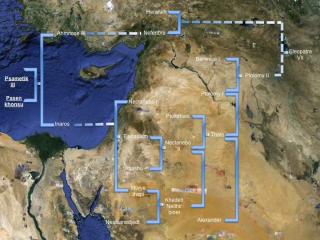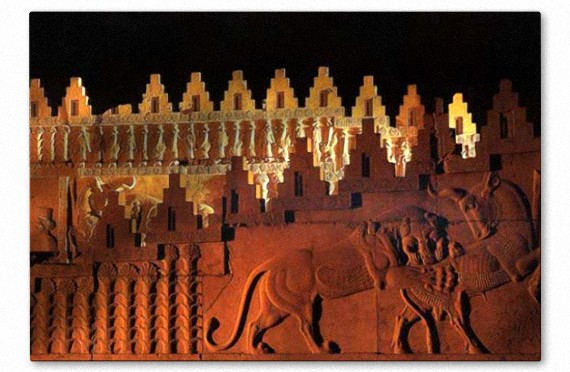Promised Land?
Egypt was threatened by Persia. It is extremely possible that the Hyskos had been pushed to the “Promised Land” to provide a buffer state against Hittite, Assyrian and eventually Persian ingressions . Quite separate attempts by Egypt to get control of the Persian Royal family failed.
The Trade Routes
From earliest recorded times there have been two trade routes which generated great wealth for those who lay in their path . The so called Silk Road, which conveyed much more than silk, led overland from China and in doing so passed through Assyria. Babylonians and Hittites, Assyrian, Egyptians and finally Persians Empire controlled the route. The Jewish states of Israel and Judah became not so much the promised, but the disputed, land and the state of Israel was totally destroyed. The spice route from East Africa, later extended to South East Asia, which was driven by the cycles of trade winds in the Indian Ocean and arabian sea made its primary landfall on either side of the red sea. Thus Persia profited from the trade carried along the silk road and Egypt profited from the spice trade.
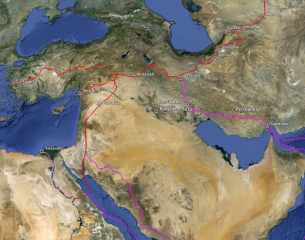
Growing Confict
Each nation knew about the two trade routes, indeed a branch of the silk road ran down through Petra into Egypt and a branch of the spice route ran from the Arabian Gulf into Central Persia. Both nations could estimate the increase in wealth which could result if they could gain total control of the trade from both routes. Egypt wanted to push north and Persia wanted to push South.
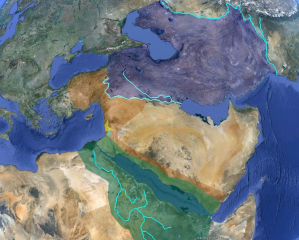
Cambreses
In 570 BC during the reign of Amasis II, the Egyptian priests were faced with two problems. Amasis was not the priestly choice for Pharoh. He was a general who had siezed power. The Priests also observed the gathering might of Persia and put in place their master plan to remove what they saw as a severe threat to their power, position and wealth. The plan involved Egyptian princesses being exported to Persia supposedly as brides of the rival rulers. A visit from a brother or an uncle then resulted in the procreation of a child who would be pure Egyptian royalty and be brought up sympathetic to Egypt. In 550 BC Neithiyti, Princess of Egypt, wife and daughter of the previous Pharoh, Apries, was married to Cyrus the Persian Emperor and bore a son Cambyses and a daughter Atossa, they also had a brother called Smyrdis. Both brothers and their sister were pure Egyptian.
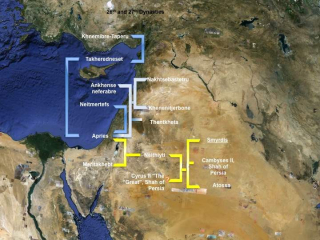
Siwa
This initiative was a failure. Cambyses did invade Egypt and after what is reputed to be on of the biggest battles of all time defeated Amasis and created a new dynasty of Pharohs.
He was probably allowed to take control of Egypt on the assumption he would comply with the Egyptian culture. It proved to be a false hope. Cambyses cut back on the taxes raised on behalf of Egyptian priests, saying famously “they are perfectly capable of raising their own geese”. Faced with determined opposition he decided that the centre of that opposition was at the oasis of Siwa, home of the Oracle of Amnon but also a formidable fortress. He set out to attack Siwa with a force of 50,000. Most of his army was killed when they found themselves in the eye of a storm. The army was buried alive in sand! Obviously the Egyptians saw this as God’s intervention.

Human Frailty
Somehow Cambyses escaped. Persian propaganda to undermine the priest’s power continued to be met with determined resistance. Cambeses in an attempt to show his contempt for the Egyptian gods killed the sacred Bull of Apis.
Shortly after this event in 522 BC his brother Smyrdis, revolted against Cambeses back in Persia. Cambeses set out to deal with the revolt but died on the way. The Egyptians of course claimed this as “Gods Judgement”. Again they were disappointed. A relative of Cambeses, uncontaminated by the Egyptian plot put down the rebellion and took control of Persia. His name was Darius. Darius assumed control of Egypt.

Darius
Darius became the greatest Persian Emperor and a champion of Zarathustra’s code of ethics. Darius however married Cambeses wife and sister Atossa in an attempt to establish the legitimacy of his rule. In part of the agreement surrounding the marriage he allowed the Magi, Priests of the Median nation, now part of the Persian Empire, to re-establish their presence. The Magi immediately set about adding additional texts to the core Zarathrustrian teaching that added the reverence, if not worship, of gods to the ethical standards. In this way Zarathustra’s teaching was converted into a religion. The Egyptians, led by their priests continued to oppose Persian attempts to limit their powers and re-educate the population. Priests and the royal family found refuge in what is now Libya

Inaros
In 460 BC Inaros defeated the Persians using Greek (Athenian) mercenaries and an Athenian fleet which sailed up the Nile as far as Memphis and totally destroyed the persian fleet. 100,000 Persians were killed in these battles but six years later Inaros was captured and crucified. The Athenian mercenary army was destroyed. The Persian rule continued.
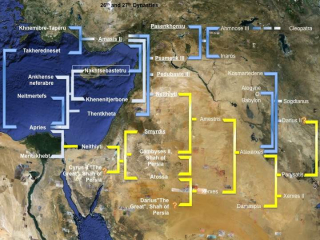
The Last Pharaoh
In 404 BC Egypt a member of the true Pharonic family, Amyraetus managed to evict the Persians again using Greek mercenaries this time both Athenians and Spartans,but six years later was overthrown by Egyptian competitors.
Non of these successors gained the approval of the priests and in 343 BC, the Persians were back again. Nectanebo the Pharoh at the time was totally outnumbered and fled to Ethiopia. Faced with continued Persian occupation, the ethics of Zarathustra permeated into Egyptian thinking.
The last native Pharoh is considered to be Nectanebo(30th dynasty 380-343). However genealogies show continued links from the 24th dynasty right through to the Ptolomies (33dynasty). Someone was still keeping control of bloodlines and in 332 BC Alexander the great was welcomed and declared to be a god and the new pharaoh. Why?
